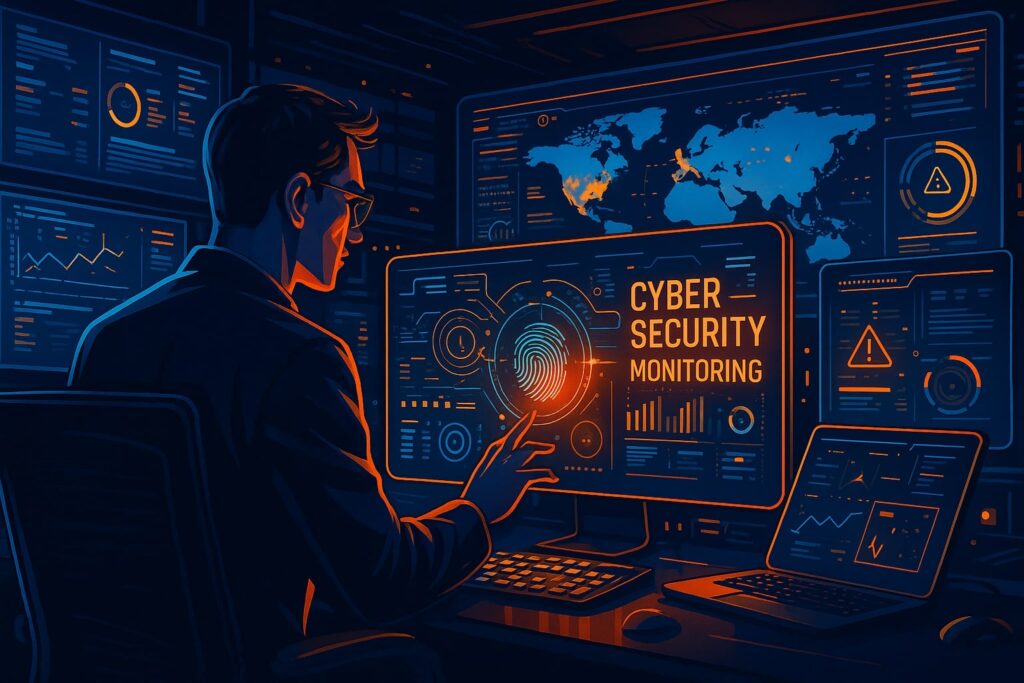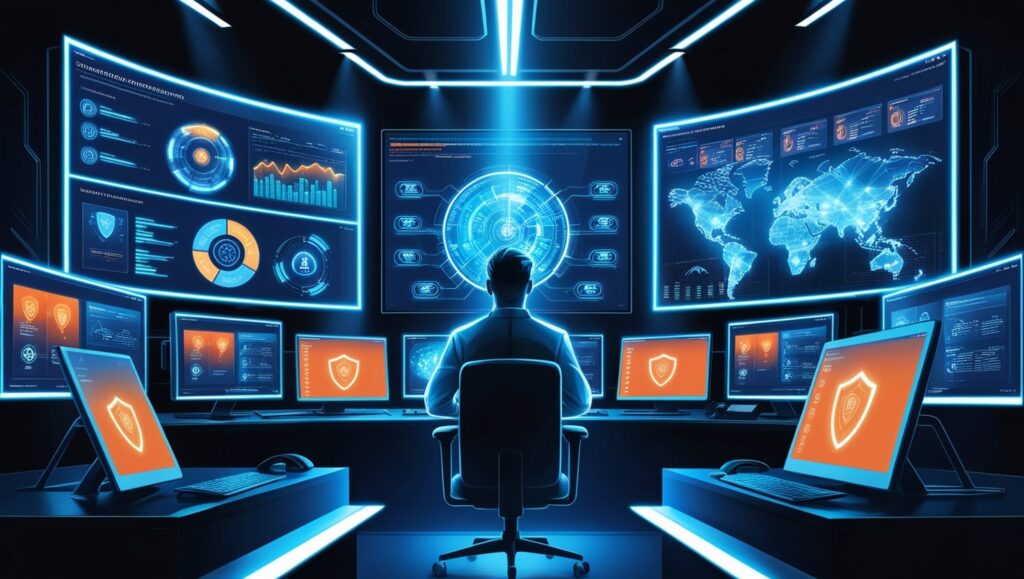In today’s hyper-connected world, businesses face a never-ending stream of cyber threats—from ransomware and phishing to insider attacks and zero-day vulnerabilities. As technology evolves, so do the tactics of bad actors. This makes cybersecurity monitoring not just a recommended practice, but a mission-critical component of any organization’s digital defense strategy.
Cybersecurity monitoring refers to the continuous observation and analysis of IT infrastructure, systems, and networks to detect, investigate, and respond to threats in real time. Unlike one-time security audits or reactive responses, this process is always active—constantly collecting data, scanning for anomalies, and generating alerts before problems escalate. It’s the difference between being a step behind and staying several steps ahead of cybercriminals.

Why cybersecurity monitoring matters
The real value of cybersecurity monitoring lies in its ability to deliver both visibility and control. Without it, organizations operate blind to the subtle signs of compromise that often precede major breaches. Real-time monitoring tools detect suspicious activity as it unfolds, enabling security teams to take immediate action. This dramatically reduces incident response times and helps prevent business disruption, data loss, and reputational damage.
Beyond immediate defense, continuous monitoring helps businesses meet the growing expectations of customers, partners, and regulators. Industries governed by strict compliance frameworks such as HIPAA, PCI DSS, and NIST 800-171 require businesses to demonstrate active oversight of their systems. Cybersecurity monitoring plays a key role in achieving and maintaining that compliance.
How It Works Behind the Scenes
At the core of any cybersecurity monitoring strategy is a combination of technologies and processes designed to collect, analyze, and interpret security data from multiple sources. This includes network traffic logs, endpoint telemetry, user activity, cloud access records, and external threat intelligence feeds. These data streams are fed into a central system—often a Security Information and Event Management (SIEM) platform—that correlates events, identifies patterns, and prioritizes alerts based on severity.
What makes modern monitoring solutions even more powerful is the integration of automation and artificial intelligence. Machine learning models can now detect behavioral anomalies with incredible accuracy, flagging even subtle deviations from a user’s normal activities. This helps organizations uncover threats that would otherwise remain hidden, such as insider risks or lateral movement by attackers within the network.
The Business Impact of Continuous Security Monitoring
Investing in cybersecurity monitoring is not just about protecting assets—it’s about enabling growth and resilience. Businesses with effective monitoring practices experience fewer breaches, shorter recovery times, and lower total cost of ownership for their security operations. Instead of reacting to emergencies, they can focus on innovation and expansion with confidence that their digital environment is being actively guarded.
Another critical benefit is risk mitigation. Monitoring systems provide early warning signals that help organizations prevent catastrophic failures—from leaked sensitive data to interrupted services. The ability to detect threats early allows companies to implement containment measures quickly, which is essential for minimizing damage and avoiding legal or financial fallout.
Cybersecurity Monitoring in the Cloud Era
As organizations migrate to cloud infrastructure, monitoring becomes even more essential. Cloud environments introduce new complexities, such as distributed workloads, multiple access points, and shared responsibility models. Fortunately, cloud-native monitoring tools are built to handle this scale, providing visibility across hybrid and multi-cloud architectures.
For businesses using platforms like AWS or Microsoft Azure, managed cybersecurity monitoring solutions offer tailored protection that aligns with cloud-native best practices. These solutions often include continuous compliance checks, real-time alerting, workload encryption verification, and user activity logging all vital components for maintaining a secure cloud posture.
Challenges and What to Watch For
Despite its benefits, implementing cybersecurity monitoring isn’t without challenges. Data overload is one of the most common issues, as monitoring systems can generate thousands of alerts daily. Without proper tuning and prioritization, this leads to alert fatigue—causing critical signals to be missed. That’s why it’s important to pair monitoring with expert management, such as a Managed Security Service Provider (MSSP), who can fine-tune systems and manage the response lifecycle.
Another common hurdle is the complexity of integrating various monitoring tools across on-premises, cloud, and remote environments. Organizations must ensure interoperability and choose platforms that provide centralized visibility to avoid blind spots. Regular audits, employee training, and clearly defined incident response protocols also play a key role in maximizing the effectiveness of a monitoring program.
Benefits of implementing cybersecurity monitoring

Beyond risk mitigation, monitoring provides long-term strategic advantages:
- Predictable Security Costs: Budgeting becomes easier when using scalable solutions like managed detection and response (MDR).
- Stronger Incident Response: Real-time alerts allow for faster isolation, remediation, and recovery.
- Enhanced Productivity: With systems operating securely and efficiently, teams can focus on core business activities.
- Improved Reputation: Clients and stakeholders feel more confident doing business with companies that demonstrate a strong cybersecurity posture.
FAQs Cybersecurity monitoring
What is a process monitor in cyber security?
A process monitor in cybersecurity is a tool or software that tracks and analyzes the behavior of running applications and processes within a system. Its main purpose is to detect anomalies, unauthorized executions, or suspicious activity that could indicate malware or a breach attempt. By continuously observing how programs interact with system resources such as memory, CPU, registry, and file systems process monitors help security teams identify and respond to threats in real time, improving overall threat detection and response capabilities.
How to monitor cyber threats?
Monitoring cyber threats involves the continuous surveillance of systems, networks, and endpoints to detect malicious activities or vulnerabilities. This process typically includes deploying tools such as SIEM (Security Information and Event Management), EDR (Endpoint Detection and Response), and IDS/IPS (Intrusion Detection and Prevention Systems). These technologies collect data from logs, traffic flows, and behavioral patterns to alert security teams about potential breaches.
What is one of the primary roles of monitoring in cybersecurity?
One of the primary roles of cybersecurity monitoring is early threat detection. By continuously observing system activities and network behavior, monitoring allows organizations to spot unusual or unauthorized activity before it escalates into a major incident. This proactive visibility helps prevent data breaches, minimize downtime, and reduce response time, making it a cornerstone of any modern cybersecurity strategy.
What are the 4 D’s of cyber security?
The 4 D’s of cybersecurity are Deter, Detect, Defend, and Document:
1.Deter involves implementing policies, awareness training, and visible protections that discourage attackers.
2.Detect refers to identifying potential threats early through monitoring and analytics.
3.Defend includes the technologies and responses used to block or contain attacks.
4.Document means recording incidents, responses, and lessons learned to improve future resilience and compliance.
Together, these pillars guide a comprehensive approach to maintaining a secure digital environment.